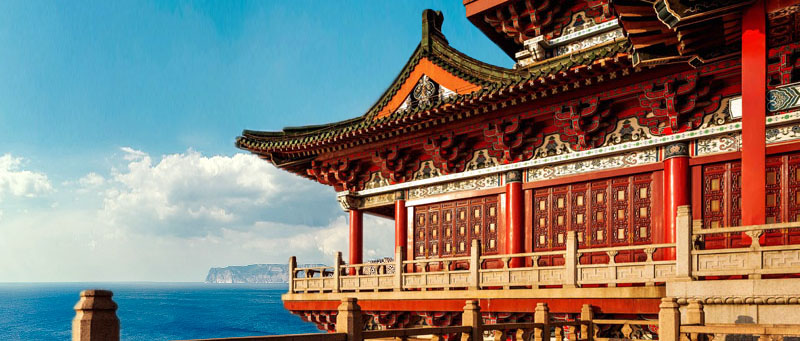Nidaf
700 years ago, the lord of Nidaf had a problem. His city sat proudly on the cliffs overlooking the entrance to Levaebu Bay. Spectacular as the view may be, it meant looking down on the ships heading for port in Mangzmat City, taking all their wealth to Mangzmat. Something had to be done about this.
That something was a ten year construction project to build a lower city on stilts at the base of the cliff, along with a staircase and elevator system to get up to the city proper. This was joined by a military outpost on the Ganga Peninsula, on the other side of the mouth of the bay. With control of the bay established, they could begin heavily taxing any vessel coming or going to Mangzmat.
With control of the bay secured, Nidaf prospered. Then came The Fourth Reckoning, the coming of the leviathans, and the drying up of shipping routes. Control over the entrance to the bay didn't mean much when the Valaran Empire, once the most regular traders to Mangzmat, dissolved and the seas became too dangerous for ships from the Rheic Islands to come through. The lower city was abandoned and subsequent lords of Nidaf watched with fury as trade travelled overland, through Jausai, and starved Nidaf of its former wealthy.
For the next few centuries, Nidaf remained an unassuming town perched by the edge of a cliff. That changed around 75 years ago, when the Aralia clan named it the capital of their new kingdom. Old ruins that had sat in disrepair since the Reckoning were remodelled and it began to see some of its former glory by funnelling all the wealth along the Dàn Coast to itself. Today, it is the largest and wealthiest city in Aralia, although it is perpetually trying to keep up with the grandeur of Taalora's capital, Temru.
That something was a ten year construction project to build a lower city on stilts at the base of the cliff, along with a staircase and elevator system to get up to the city proper. This was joined by a military outpost on the Ganga Peninsula, on the other side of the mouth of the bay. With control of the bay established, they could begin heavily taxing any vessel coming or going to Mangzmat.
With control of the bay secured, Nidaf prospered. Then came The Fourth Reckoning, the coming of the leviathans, and the drying up of shipping routes. Control over the entrance to the bay didn't mean much when the Valaran Empire, once the most regular traders to Mangzmat, dissolved and the seas became too dangerous for ships from the Rheic Islands to come through. The lower city was abandoned and subsequent lords of Nidaf watched with fury as trade travelled overland, through Jausai, and starved Nidaf of its former wealthy.
For the next few centuries, Nidaf remained an unassuming town perched by the edge of a cliff. That changed around 75 years ago, when the Aralia clan named it the capital of their new kingdom. Old ruins that had sat in disrepair since the Reckoning were remodelled and it began to see some of its former glory by funnelling all the wealth along the Dàn Coast to itself. Today, it is the largest and wealthiest city in Aralia, although it is perpetually trying to keep up with the grandeur of Taalora's capital, Temru.
The Lower City
Nidaf has a sharp divide between its slums and the city proper. The lower city at the bottom of the cliff still exists, although it has not been formally administered since the Reckoning.
After the city government abandoned it, the neighbourhood on stilts became a haven for the poor, the outcast, and the criminal. Much of it has crumbled, but the parts supported by stone, especially close to the cliff wall, are still relatively stable. Local authorities never go down there, because a soldier in uniform is more likely to get mugged and murdered than obeyed. The city government have no interest in destroying it, because they see it as akin to a quarantine zone. The royal treasurer once remakred,
The only people who willingly go to the lower city are those looking to commit a crime. It's where you go to find prostitutes, stolen goods, or hitmen.
After the city government abandoned it, the neighbourhood on stilts became a haven for the poor, the outcast, and the criminal. Much of it has crumbled, but the parts supported by stone, especially close to the cliff wall, are still relatively stable. Local authorities never go down there, because a soldier in uniform is more likely to get mugged and murdered than obeyed. The city government have no interest in destroying it, because they see it as akin to a quarantine zone. The royal treasurer once remakred,
Take Nidaf and shake it. The dregs of society will fall through the cracks to that warren of filth on stilts, and leave the city proper free of their contamination.If you're down on your luck, can't find employment, evicted from even the cheapest of housing in Nidaf, and out of options, there is always a home to be found in the lower city. It might be nothing more than a sheltered nook in a crumbling alley, but it's a home. People don't move to the lower city; they end up there. Children born and raised on the stilts are particularly disadvantaged, as there is nothing in the way of education or structure. They eat whatever they can pull up from the bay and scrounge for supplies from the trash Nidaf throws over the side.
The only people who willingly go to the lower city are those looking to commit a crime. It's where you go to find prostitutes, stolen goods, or hitmen.
Type
Large city
Population
87,905
Location under
Owning Organization


